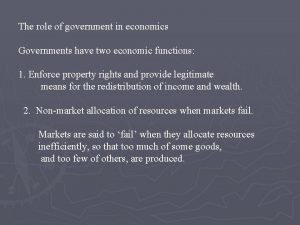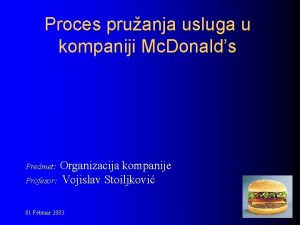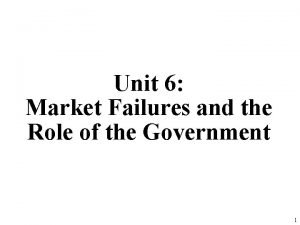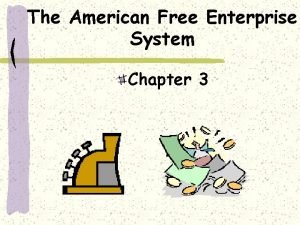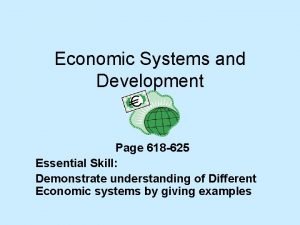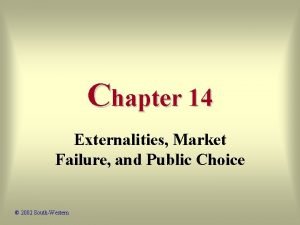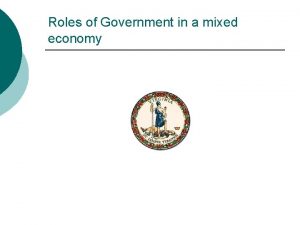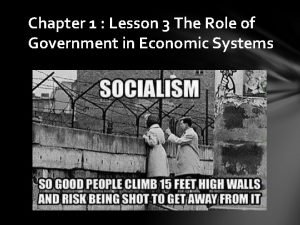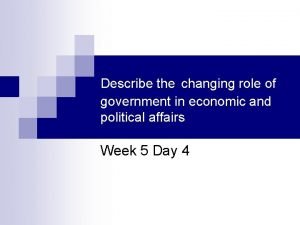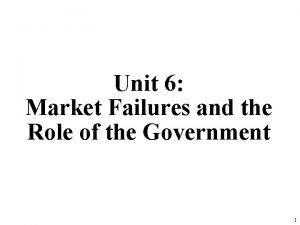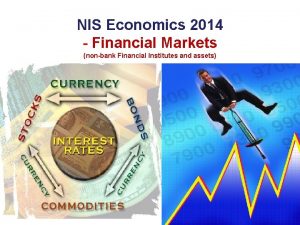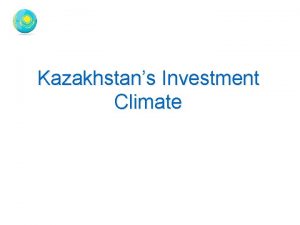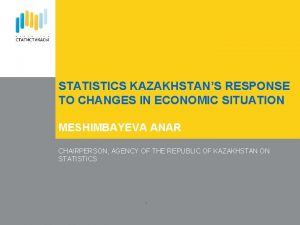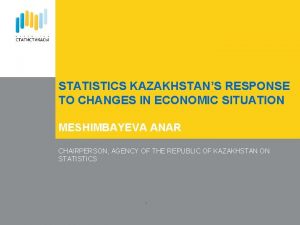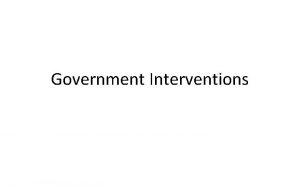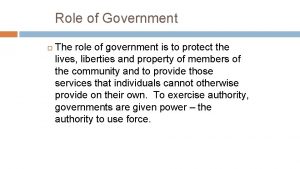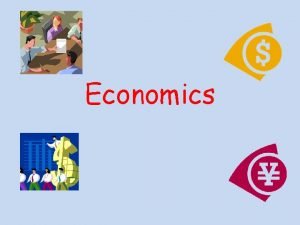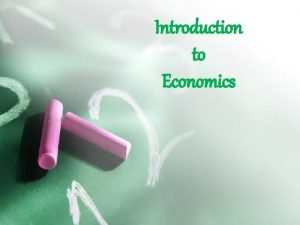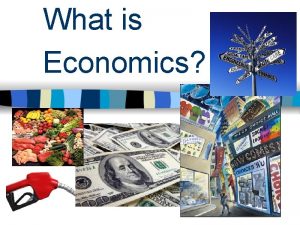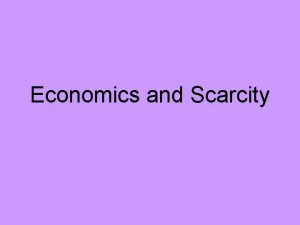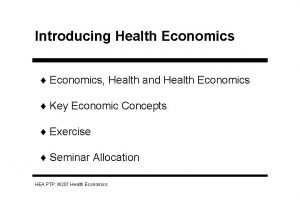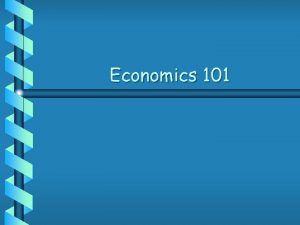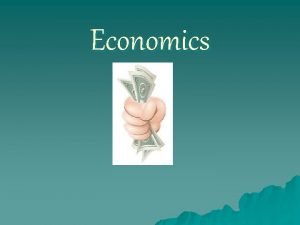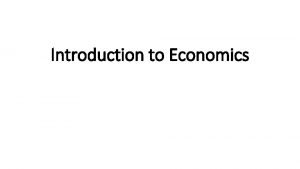NIS Economics 2014 The role of Kazakhstans government























































- Slides: 55

NIS Economics 2014 - The role of Kazakhstan’s government in the macro-economy; other policies and their application



Today we will look at: The role of the Kazakhstan’s government in improving the macro-economy in terms of: GDP, HDI, Inflation, Unemployment, Trading position (Bof. P) The role of Monetary Policy Fiscal Policy Supply side policy (taxation) Exchange rate policy – The reason for the Kazakhstan’s devaluation and its implications. Kazakhstan’s government and its macroeconomic objectives

WHAT IS THE ROLE OF THE GOVERNMENT IN THE MACROECONOMY? To make sure the economy is strong this means low inflation, strong economic growth and low unemployment.

HOW DOES THE KAZAKHSTAN GOVERNMENT ACHIEVE THESE GOALS? By using: • Monetary policy • Fiscal policy • Supply side policy and • Exchange rate policy



MONETARY POLICY Monetary policy: monetary policy deals with the money supply, lending rates and interest rates and is administered by a central bank. For example: lowering of the interest rates, or raising interest rates.

MONETARY POLICY – STIMULUS (GROWING THE ECONOMY The government can either stimulate the economy (grow the economy) by lowering interest rates, or slow the economy by increasing interest rates, lowering of the cost of borrowing. A lowering of interest rates will lead to an increase in borrowing and investment, consumption, employment and economic growth. This is a stimulating monetary policy because it stimulates economic growth. However, higher economic growth will contribute to higher inflation in the economy, ceteris paribus.

MONETARY POLICY – CONTRACTING THE ECONOMY (SLOWING ECONOMIC GROWTH An increase in interest rates will increase the cost of borrowing and less people will borrow and invest in the economy. This will lead to less spending, an increase in unemployment and reduce the level of economic growth. Lower economic growth will also help to lower the inflation rate, ceteris paribus.

MONETARY POLICY – THE PROBLEM OF INFLATION An lowering of interest rates will increase inflation and is therefore not always desirable. The government cannot simply lower interest rates without thinking about the problem of high inflation – remember Germany in 1930? (powerpoint class, week 4) Lowering interest rates increased money supply in the economy more cash, but still possibly the same level (number) of of output. . Thus prices must go up!

MONETARY POLICY – THE PROBLEM OF INFLATION We can see from the philips curve that as we lower the level of unemployment, there will be higher inflation… Philips Curve Monetary stimulus So… interest rates spending and investment é economic growth ê unemployment… BUT ALSO ……. INFLATION

MONETARY POLICY – THE PROBLEM OF INFLATION The government may also lower inflation by raising interest rates, however spending, economic growth levels will fall; and unemployment levels will rise. Philips Curve Monetary contraction So… interest rates spending and investment ê economic growth unemployment… BUT ALSO ……. INFLATION

MONETARY POLICY – THE TWO OPTIONS



FISCAL PLOICY Fiscal policy is about government taxing and spending. What they take as taxes and what they spend on schools, roads, hospitals, etc.

Governments consume by spending in the economy (this grows the economy) Governments take money out of the economy by taxing (this slows the economy)



FISCAL POLICY • Fiscal policy – governments collect tax and spend money (Government expenditure). By spending more than the taxation level the government can increase GDP, and visa versa. By using this tool over the business cycle the government can A. Prevent recession (via fiscal expansion) B. OR lower inflation rates during booming economic growth (via fiscal contraction).

FISCAL POLICY • When government spending is greater than taxation there will be fiscal stimulus, however the government will have a budget deficit (they will accumulate a debt, this means they must borrow). This will stimulate economic growth. • When the government spends less than they tax there will be fiscal contraction in the economy, this will result in the government saving more money and achieving a budget surplus (Saving more money than they spend). However, this will contract the economy (lower the level of economic growth)

FISCAL POLICY – FISCAL STIMULUS • Fiscal stimulation will lead to an increase in spending in the economy (via increased government spending, called government stimulus) and this creates more jobs (lowering the unemployment rate). • When more people have jobs they spend more money so consumption increases and so there is an increase in economic growth. However, higher economic growth will contribute to higher inflation in the economy, ceteris paribus.

FISCAL POLICY – FISCAL CONTRACTION • Fiscal contraction will lead to an decrease in spending in the economy and this reduces the level of economic growth by reducing consumption and investment. This increases unemployment, however it also helps to lower the inflation rate, ceteris paribus.

FISCAL POLICY – THE PROBLEMS WITH CONTRACTION OR STIMULUS. • Fiscal contraction problems Slower economic growth and increased unemployment levels. • Fiscal stimulus problems increased government debt and pressure in inflation (pressure on the inflation rate to rise).

WHY DOES INFLATION RISE WHEN THE ECONOMY IS STIMULATED? The inflation effect here is due to an increase in spending in the economy but no equal increase in output… Thus, as we mentioned before, more money is being spend but more goods are not available therefore prices go up, like in Germany, 1930. THIS INFLATION EFFECT IS TRUE FOR BOTH: A. FISCAL STIMULUS B. MONETARY STIMULUS

Government borrowing to put more money into the economy can prices if output does not also. Imagine a shop has 10 goods to sell, If more people have more money to buy these goods the shop will the Money is worth less. price… inflation. This is how fiscal stimulus can cause inflation.

REMEMBER THE EQUATION FOR GDP? Total dollar value of all goods and services produced in the economy, indicates the wealth of a country. That is: GDP = C + S + G + (X-M) Or GDP = C + I + G + (X-M) … Where S = I C = Consuption I = Investment S = Savings G = Government spending (X-M) = Balance of trade

REMEMBER THE EQUATION GDP That is: GDP = C + S + G + (X-M) Or GDP = C + I + G + (X-M) C = Consuption I = Investment S = Savings … Where S = I G = Government spending (X-M) = Balance of trade

REMEMBER THE EQUATION GDP But G is actually the difference between government spending (GS) and government taxes (GT) That is: G= GS – GT

REMEMBER THE EQUATION GDP So if GS > GT stimulus because G is positive the level of GDP will rise. Rising GDP is called economic growth. If GS>GT… G>0 GDP economic growth

REMEMBER THE EQUATION GDP So if GT > GS economic contraction because G is negative growth in GDP will be lower. Lower GDP growth is called a “slowing down” of the economic activity. If GS<GT… G<0 GDP economic growth

THE PROBLEM OF FISCAL EXPANSION AND GOVERNMENT DEBT So if governments spend more than they tax they can grow the economy increase in GDP = C + I + (GS – GT) + (X-M) But if GS > GT the government must BORROW that extra money this means an increase in government debt.

FISCAL POLICY - LIMITATIONS So as you can see Fiscal policy cannot grow the economy forever without causing an increase in the governments debt (and as we said earlier pressure inflation to rise) These two issues prevent governments form always using Fiscal Policy to grow the economy.

FISCAL and MONETARY POLICY – THE INFLATION PROBLEM: A SIMPLE WAY TO UNDERSTAND IT: imagine an economy has 10 goods to sell, 10 customers with $10 each. The price will be $10 per good. What if customers now have $20 each? The price will rise to $20 per good. INFLATION. FISCAL AND MONETARY STIMULUS TEND TO PUT PRESSURE ON THE INFLATION RATE TO RISE.

BUT WHAT IF…

HIGH TAXES DISCOURAGE BUSINESS GROWTH?

SUPPLY SIDE POLICY Governments must make sure that their taxes and regulation do not inhibit (stop) businesses from growing. Too much tax and regulations will discourage businesses from growing.

SUPPLY SIDE POLICY So the government wants to raise tax… OK, so how much should they try to raise? Do economist have any advise for governments about the best way to work out the best level of taxation? …. . YES.

NOW… IF: TOO MUCH TAX PEOPLE STOP WORKING IF: TOO LITTLE TAXATION GOVERNMENTS DON’T HAVE ENOUGH MONEY TO FUNCTION.

TOO MUCH TAX PEOPLE STOP WORKING Imagine you are working in a shop and the government takes all of your wage. Would you continue to work? NO Or if the government takes non of your wage, would there be money for roads, hospitals and schools? NO

SUPPLY SIDE POLICY Supply side theory says that there is a level of taxation which maximizes total government revenues. Above and below this level of taxation and there is a lower level of total taxation It can be shown on a graph as follows: Thanks to the economist Laffer for this curve…

Above the maximum tax rate – People decide to not work so much lower total tax Below this point More money can be made if tax is raised.

Economics is a bit complex but we are almost finished!

AND NOW… EXCHANGE RATE POLICY IN KAZAKHSTAN

EXCHANGE RATE POLICY IN KAZAKHSTAN Kazakhstan has twice devalued its exchange rate (currency value) in the last 10 years. This devaluation has some positive and negative effects on the economy.

KAZAKHSTAN’S CURRENCY DEVALUATION • A lower currency value will reduce the cost of Kazakhstan’s exports foreigners, and therefore they will buy more. This will increase Kazakhstan’s export sector and help to grow Kazakhstan’s economy. • On the downside, however, (the negative side) this devaluation will increase the price of imports and this will flow through the economy and increase prices in general.

KAZAKHSTAN’S CURRENCY DEVALUATION But how did the currency devaluation impact on inflation in Kazakhstan?

KAZAKHSTAN’S CURRENCY DEVALUATION – What do you think? The currency was devalued in February 16, 2014.

KAZAKHSTAN’S CURRENCY DEVALUATION- THE UPSIDE (POSITIVE EFFECTS) • However, on the upside, if imports are more expensive, local Kazak people will buy more locally made products and this will increase economic activity in Kazakhstan. There will be higher sales for local companies and lower levels of imports. • This devaluation policy is designed to improve Kazakhstan’s trade position. This means: increase the level of exports and decrease the level of imports.

KAZAKHSTAN’S CURRENCY DEVALUATION- THE UPSIDE (POSITIVE EFFECTS) The currency devaluation should expand export sectors and reduce the level of imports – resulting in an improvement in the Balance of Payments

KAZAKHSTAN’S CURRENCY DEVALUATION- THE UPSIDE (POSITIVE EFFECTS) SO DID IT WORK?

KAZAKHSTAN’S CURRENCY DEVALUATION- THE UPSIDE (POSITIVE EFFECTS) According to the World Bank – YES. Kazakhstan had a balance of payments (Bof. P) deficit of 0. 5% in 2013 But there is a expected to be a Bof. P surplus of 1% of GDP in 2014. See for yourself

Today we looked look at: The role of the Kazakhstan’s government in improving the macro-economy. The role of Monetary Policy Fiscal Policy Supply side policy (taxation) Kazakhstan’s devaluation and its implications. Kazakhstan’s government and its macroeconomic objectives.
 Economic role of government
Economic role of government Economics and business economics maastricht
Economics and business economics maastricht Mathematical economics vs non mathematical economics
Mathematical economics vs non mathematical economics Nis bank lorenzen
Nis bank lorenzen Nis cooperation group
Nis cooperation group Klizaliste nis
Klizaliste nis Psihogalvanski refleks
Psihogalvanski refleks Son logo nigeria
Son logo nigeria Nis gdpr
Nis gdpr Uprava za komunalne delatnosti niš
Uprava za komunalne delatnosti niš Kvalitet ad nis
Kvalitet ad nis Nis africa
Nis africa Mc donalds nis
Mc donalds nis Linux
Linux 34$ to nis
34$ to nis Dimitrovgrad sofija km
Dimitrovgrad sofija km Ddo duping
Ddo duping Kafana zona zamfirova niš
Kafana zona zamfirova niš Lekarski za sportiste
Lekarski za sportiste Nis.getalma
Nis.getalma National powers
National powers Unit 6 market failures and the role of the government
Unit 6 market failures and the role of the government How are conflicts among economic goals resolved
How are conflicts among economic goals resolved Role of government in economic development
Role of government in economic development Role of government in correcting market failure
Role of government in correcting market failure What is the role of the government in a mixed economy
What is the role of the government in a mixed economy Disaster management
Disaster management Lesson 3 the role of government in economic systems
Lesson 3 the role of government in economic systems Changing role of government in the economy
Changing role of government in the economy Unit 6 market failures and the role of the government
Unit 6 market failures and the role of the government What is web role and worker role in azure
What is web role and worker role in azure Krappmann symbolischer interaktionismus
Krappmann symbolischer interaktionismus Role conflict occurs when fulfilling the role expectations
Role conflict occurs when fulfilling the role expectations Thiếu nhi thế giới liên hoan
Thiếu nhi thế giới liên hoan Phối cảnh
Phối cảnh điện thế nghỉ
điện thế nghỉ Một số thể thơ truyền thống
Một số thể thơ truyền thống Thế nào là hệ số cao nhất
Thế nào là hệ số cao nhất Ng-html
Ng-html Sơ đồ cơ thể người
Sơ đồ cơ thể người Bảng số nguyên tố
Bảng số nguyên tố đặc điểm cơ thể của người tối cổ
đặc điểm cơ thể của người tối cổ Các châu lục và đại dương trên thế giới
Các châu lục và đại dương trên thế giới Tư thế worms-breton
Tư thế worms-breton ưu thế lai là gì
ưu thế lai là gì Tư thế ngồi viết
Tư thế ngồi viết Thẻ vin
Thẻ vin Cái miệng nó xinh thế
Cái miệng nó xinh thế Các châu lục và đại dương trên thế giới
Các châu lục và đại dương trên thế giới Mật thư tọa độ 5x5
Mật thư tọa độ 5x5 Bổ thể
Bổ thể Từ ngữ thể hiện lòng nhân hậu
Từ ngữ thể hiện lòng nhân hậu Tư thế ngồi viết
Tư thế ngồi viết V cc cc
V cc cc Thể thơ truyền thống
Thể thơ truyền thống Bài hát chúa yêu trần thế alleluia
Bài hát chúa yêu trần thế alleluia
